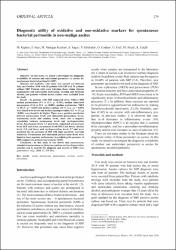Diagnostic utility of oxidative and non-oxidative markers for spontaneous bacterial peritonitis in non-malign ascites

View/
Access
info:eu-repo/semantics/openAccessDate
2020Author
Kaplan, MustafaAteş İ.
Kayhan, M. Akdoğan
Kaçar S.
Gökbulut V.
Coşkun O.
Erel Ö.
Alışık M.
Güçlü K.
Metadata
Show full item recordCitation
Kaplan, M., Ateş, İ., Kayhan, M. A., Kaçar, S., Gökbulut, V., Coşkun, O., ... & Güçlü, K. (2020). Diagnostic utility of oxidative and non-oxidative markers for spontaneous bacterial peritonitis in non-malign ascites. Acta Gastro-Enterologica Belgica, 83.Abstract
Objective: In this study, we aimed to investigate the diagnostic availability of oxidant and antioxidant parameters in ascites for spontaneous bacterial peritonitis (SBP). Material and methods: This study was carried out between July and October 2018 with 25 patients with SBP and 24 patients without SBP. Patients with acute infection, those taking vitamin supplements and antioxidant medication, smoking and drinking alcohol, and patients without ascites culture were excluded from the study. Results: In patients with SBP compared those without SBP median paraoxonase (3.1 vs 15.6; p <0.001), median stimulated paraoxonase (12.6 vs 53.1; p <0.001), median arylesterase (769,9 vs 857,5; p = 0,003) and median catalase (10 vs 22,2; p = 0,003) were found to be lower and median myeloperoxidase (8.1 vs 1.1; p <0.001) were found to be higher. There was a positive correlation between paraoxonase levels and stimulated paraoxonase levels, arylesterase levels and catalase levels, there was a negative correlation between paraoxonase levels and myeloperoxidase levels. Paraoxonase levels 3.7 and lower, stimulated paraoxonase levels 25.8 and lower, arylesterase levels 853.4 and lower, catalase levels 11.8 and lower and myeloperoxidase levels 2.7 and more predicted the the presence of SBP with high specificity and high sensitivity. Paraoxonase and stimulated paraoxo-nase levels were found to have superior performance in predicting the presence of SBP compared to arylesterase levels (p <0.05). Conclusion: In this study it was shown that paraoxonase, stimulated paraoxonase, arylesterase, catalase and myeloperoxidase activities can be used for the diagnosis and severity of SBP. © 2020, Universa Press. All rights reserved.

















